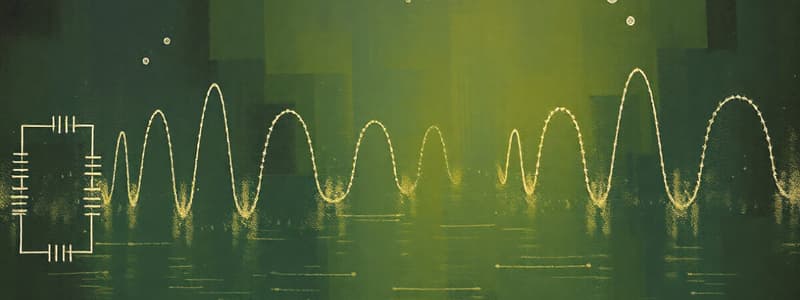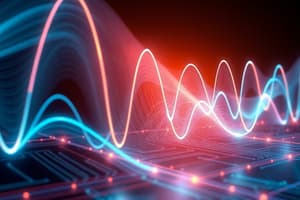Podcast
Questions and Answers
What is a major disadvantage of using a phase shift oscillator?
What is a major disadvantage of using a phase shift oscillator?
- It produces high output.
- It operates only at high frequencies.
- It has difficulty starting oscillations due to small feedback. (correct)
- It is complex to design.
A Wien-bridge oscillator can only operate within the frequency range of 1 Hz to 10 MHz.
A Wien-bridge oscillator can only operate within the frequency range of 1 Hz to 10 MHz.
False (B)
What is the resistive value (in ohms) used in the phase shift oscillator example?
What is the resistive value (in ohms) used in the phase shift oscillator example?
1 MΩ
In the Wien-bridge oscillator, the two transistors together produce a total phase shift of ____ degrees.
In the Wien-bridge oscillator, the two transistors together produce a total phase shift of ____ degrees.
Match the following oscillator types with their characteristics:
Match the following oscillator types with their characteristics:
At what frequency does the given phase shift oscillator circuit oscillate when R=1MΩ and C=68pF?
At what frequency does the given phase shift oscillator circuit oscillate when R=1MΩ and C=68pF?
The output of the Wien-bridge oscillator is influenced by circuit fluctuations and ambient temperature.
The output of the Wien-bridge oscillator is influenced by circuit fluctuations and ambient temperature.
What component in the Wien-bridge oscillator helps stabilize the amplitude of the output?
What component in the Wien-bridge oscillator helps stabilize the amplitude of the output?
What is the formula for the frequency of oscillation in a Hartley oscillator?
What is the formula for the frequency of oscillation in a Hartley oscillator?
The voltage across L2 is 90° out of phase with the voltage developed across L1 in a Hartley oscillator.
The voltage across L2 is 90° out of phase with the voltage developed across L1 in a Hartley oscillator.
What is the feedback fraction (${m_v}$) in a Hartley oscillator?
What is the feedback fraction (${m_v}$) in a Hartley oscillator?
The center of inductors in a Hartley oscillator is placed across a common capacitor _____.
The center of inductors in a Hartley oscillator is placed across a common capacitor _____.
Match the oscillator type with its characteristic:
Match the oscillator type with its characteristic:
In a tank circuit, what components determine the oscillation frequency?
In a tank circuit, what components determine the oscillation frequency?
The mutual inductance (M) contributes to the total inductance (L_T) in a Hartley oscillator.
The mutual inductance (M) contributes to the total inductance (L_T) in a Hartley oscillator.
What role does the transistor play in a Hartley oscillator?
What role does the transistor play in a Hartley oscillator?
What is the total inductance $L_T$ in the circuit if $L_1 = 1000 , ext{μH}$, $L_2 = 100 , ext{μH}$, and $M = 20 , ext{μH}$?
What is the total inductance $L_T$ in the circuit if $L_1 = 1000 , ext{μH}$, $L_2 = 100 , ext{μH}$, and $M = 20 , ext{μH}$?
The Hartley oscillator can be designed to use inductors for generating frequencies of up to 1MHz.
The Hartley oscillator can be designed to use inductors for generating frequencies of up to 1MHz.
What is the formula for the frequency of oscillations in a phase shift oscillator?
What is the formula for the frequency of oscillations in a phase shift oscillator?
In a phase shift oscillator, each RC section contributes a phase shift of ___ degrees.
In a phase shift oscillator, each RC section contributes a phase shift of ___ degrees.
Match the following components with their correct functions:
Match the following components with their correct functions:
What is the value of the capacitor needed for the oscillator if $C = 20 pF$?
What is the value of the capacitor needed for the oscillator if $C = 20 pF$?
Phase-shift oscillators are not suitable for very low frequencies.
Phase-shift oscillators are not suitable for very low frequencies.
What is the value of $L_1$ if $m_v = 0.2$ and $L_2 = 4.22 mH$ in a Hartley oscillator?
What is the value of $L_1$ if $m_v = 0.2$ and $L_2 = 4.22 mH$ in a Hartley oscillator?
Flashcards
Hartley Oscillator Frequency
Hartley Oscillator Frequency
The frequency of oscillations in a Hartley oscillator is determined by the values of the inductance (L1 + L2 + 2M) and capacitance (C) in the tank circuit, calculated as 1/(2π√(L_T*C)).
Hartley Oscillator Tank Circuit
Hartley Oscillator Tank Circuit
The tank circuit in a Hartley oscillator consists of two inductors (L1 and L2) and a capacitor (C) connected in a specific arrangement.
Hartley Oscillator Feedback Fraction
Hartley Oscillator Feedback Fraction
The feedback fraction (mV) in a Hartley oscillator is determined by the ratio of the voltage across inductor L2 to the output voltage (Vout), calculated as L2/L1.
Mutual Inductance (M)
Mutual Inductance (M)
Signup and view all the flashcards
Oscillation Phase Shift
Oscillation Phase Shift
Signup and view all the flashcards
Oscillator Operation (Initial)
Oscillator Operation (Initial)
Signup and view all the flashcards
Oscillator Feedback Network
Oscillator Feedback Network
Signup and view all the flashcards
Colpitts Oscillator Comparison
Colpitts Oscillator Comparison
Signup and view all the flashcards
Hartley Oscillator Inductor Value Calculation
Hartley Oscillator Inductor Value Calculation
Signup and view all the flashcards
Inductor Ratio for Hartley Oscillator
Inductor Ratio for Hartley Oscillator
Signup and view all the flashcards
Total Inductance Calculation
Total Inductance Calculation
Signup and view all the flashcards
Phase Shift Oscillator Frequency
Phase Shift Oscillator Frequency
Signup and view all the flashcards
Phase Shift Oscillator Components
Phase Shift Oscillator Components
Signup and view all the flashcards
Phase Shift Frequency Stability
Phase Shift Frequency Stability
Signup and view all the flashcards
Phase Shift Oscillator Advantages
Phase Shift Oscillator Advantages
Signup and view all the flashcards
Phase shift oscillator operation
Phase shift oscillator operation
Signup and view all the flashcards
Phase Shift Oscillator Frequency (formula)
Phase Shift Oscillator Frequency (formula)
Signup and view all the flashcards
Phase Shift Oscillator Capacitor Value (example)
Phase Shift Oscillator Capacitor Value (example)
Signup and view all the flashcards
Wien Bridge Oscillator Frequency (formula)
Wien Bridge Oscillator Frequency (formula)
Signup and view all the flashcards
Wien Bridge Oscillator Application Range
Wien Bridge Oscillator Application Range
Signup and view all the flashcards
Wien Bridge Oscillator Output Stability
Wien Bridge Oscillator Output Stability
Signup and view all the flashcards
Wien Bridge Circuit Components
Wien Bridge Circuit Components
Signup and view all the flashcards
Wien Bridge Oscillator Feedback (Positive & Negative)
Wien Bridge Oscillator Feedback (Positive & Negative)
Signup and view all the flashcards
Study Notes
Sinusoidal Oscillators
- Sinusoidal oscillators generate a desired frequency. They do not create energy, but convert DC energy into AC energy.
- Oscillator frequency depends on the device's constants.
- Positive feedback is crucial for oscillations.
- Barkhausen criterion is a condition for transistor oscillators.
- Types of transistor oscillators include tuned RC, Colpitts, Hartley, phase shift, Wien-bridge, and crystal oscillators.
- Feedback is the process of injecting a fraction of output energy back to the input.
- Positive feedback: The feedback energy is in phase with the input signal, boosting amplifier gain but increasing distortion and instability. Primarily used in oscillators.
- Negative feedback: The feedback energy is out of phase with the input, reducing gain but decreasing distortion and improving stability.
Advantages of Oscillators
- High durability due to lack of moving parts.
- Quiet operation due to the absence of moving parts.
- Wide frequency range (20 Hz to 100 MHz).
- Adjustable frequency.
- Stable frequency over time.
- High efficiency.
Feedback
- Feedback is injecting a fraction of device output energy back to the input.
- Positive feedback aids the input signal and increases amplifier gain but increases distortion and instability.
- Positive feedback is crucial for oscillators.
- Negative feedback opposes the input signal, reducing amplifier gain but reducing distortion, improving stability, and increasing bandwidth.
Positive Feedback Amplifier - Oscillator
- A transistor amplifier with proper positive feedback acts as an oscillator.
- It produces a feedback voltage (Vf) in phase with the input signal.
- Amplifier produces a 180° phase shift, and the feedback network adds another 180° phase shift. This results in a total of 360° phase shift, making the feedback signal in phase with the input signal, creating oscillations.
Barkhausen Criterion
- Barkhausen criterion ensures continuous, undamped oscillations in an amplifier with positive feedback.
- The condition is Av * m₁ = 1, where Av is the voltage gain of the amplifier without feedback, and m₁ is the feedback fraction.
Types of Transistor Oscillators
- Tuned Collector Oscillator: Uses a tuned circuit in the collector, magnetically coupled feedback coil in the base.
- Colpitts Oscillator: Uses two capacitors and a common inductor; the frequency of oscillation depends on the values of the components, and the feedback fraction depends on the capacitances.
- Hartley Oscillator: Uses two inductors and a common capacitor. The frequency of oscillation is determined by the inductors and capacitor values, and the feedback fraction depends on the inductors' values.
- Phase Shift Oscillator: Uses multiple RC sections to create a 180° phase shift. Frequency is determined by the resistors and capacitors values. A simple circuit, often used for low frequencies.
- Wien Bridge Oscillator: A two-stage amplifier with an RC bridge circuit; frequency is determined by the resistors and capacitors; uses feedback to maintain stability and constant output.
- Crystal Oscillator: Uses a piezoelectric crystal as a part of the feedback network, which greatly improves frequency stability due to the crystal's high quality factor and inherent frequency resonance. Not easily adjustable and prone to damage due to its fragility.
Crystal Oscillators
- Piezoelectric crystals exhibit a piezoelectric effect, where they vibrate at the applied AC frequency and vice versa.
- High frequency stability and a robust, consistent frequency.
Other Oscillator Components
- RF Choke: A coil that blocks radio frequency (RF) signals.
- Capacitor: Stores electrical energy.
- Resistor: Resist the flow of current.
- Inductor: A coil that stores energy in a magnetic field.
- Mutual Inductance: The property of two coils to induce a voltage or current in each other.
Studying That Suits You
Use AI to generate personalized quizzes and flashcards to suit your learning preferences.




